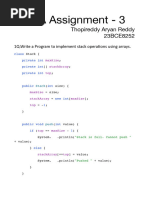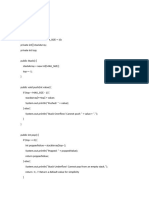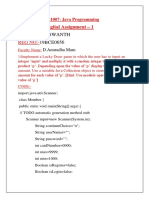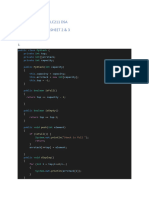Java Stack Implementation and Date Class Implementation
Uploaded by
Saravanakumar MuthulakshmiJava Stack Implementation and Date Class Implementation
Uploaded by
Saravanakumar MuthulakshmiStack program output [cs2910007@localhost java]$ java Stack Menu 1.Push 2.Pop 3.Peek 4.Display 5.
Exit Enter ur choice 1 Enter element 10 Menu 1.Push 2.Pop 3.Peek 4.Display 5.Exit Enter ur choice 1 Enter element 20 Menu 1.Push
2.Pop 3.Peek 4.Display 5.Exit Enter ur choice 1 Enter element 30 Menu 1.Push 2.Pop 3.Peek 4.Display 5.Exit Enter ur choice 1 Enter element 40 Menu 1.Push 2.Pop 3.Peek 4.Display 5.Exit Enter ur choice
1 Enter element 50 Menu 1.Push 2.Pop 3.Peek 4.Display 5.Exit Enter ur choice 1 Overflow-----maximum linit reached Menu 1.Push 2.Pop 3.Peek 4.Display 5.Exit Enter ur choice 3 Peek element(elemet inserted at last is50 Menu 1.Push 2.Pop 3.Peek
4.Display 5.Exit Enter ur choice 4 Elements are 10 20 30 40 50 Menu 1.Push 2.Pop 3.Peek 4.Display 5.Exit Enter ur choice 2 Popped element50 Menu 1.Push 2.Pop 3.Peek 4.Display 5.Exit Enter ur choice 2 Popped element40 Menu 1.Push
2.Pop 3.Peek 4.Display 5.Exit Enter ur choice 2 Popped element30 Menu 1.Push 2.Pop 3.Peek 4.Display 5.Exit Enter ur choice 2 Popped element20 Menu 1.Push 2.Pop 3.Peek 4.Display 5.Exit Enter ur choice 2 Popped element10
Menu 1.Push 2.Pop 3.Peek 4.Display 5.Exit Enter ur choice 2 Underflow----no element in stack Menu 1.Push 2.Pop 3.Peek 4.Display 5.Exit Enter ur choice
program code
import java.lang.*; import java.io.*; import java.util.*; interface Mystack {
int n=5; public void pop(); public void push(); public void peek(); public void display(); }
class stack implements Mystack { int stack[]=new int[n]; int top=-1; public void push() { try { DataInputStream dis=new DataInputStream(System.in); if(top==(n-1)) { System.out.println("Overflow-----maximum linit reached"); return; } else { System.out.println("Enter element"); int ele=Integer.parseInt(dis.readLine());
stack[++top]=ele; } } catch(Exception e) { System.out.println("e"); } } public void pop() { if(top<0) { System.out.println("Underflow----no element in stack"); return; } else { int popped=stack[top]; top--; System.out.println("Popped element"+popped); } }
public void peek() {
if(top<0) { System.out.println("Underflow -- no elememt in stack "); return; } else { int popped=stack[top]; System.out.println("Peek element(elemet inserted at last is"+popped); } }
public void display() { if(top<0) { } else { String str=" "; for(int i=0;i<=top;i++) str=str+" "+stack[i]; System.out.println("Elements are"+str); } }
class Stack {
public static void main(String arg[])throws IOException { DataInputStream dis=new DataInputStream(System.in); stack stk=new stack(); int ch=0; do { System.out.println("Menu\n 1.Push\n 2.Pop\n 3.Peek\n 4.Display\n 5.Exit\n Enter ur choice"); ch=Integer.parseInt(dis.readLine()); switch(ch) { case 1: stk.push(); break; case 2: stk.pop(); break; case 3:
stk.peek(); break; case 4: stk.display(); break; case 5: System.exit(0); } }while(ch<=5); } }
[cs2910007@localhost java]$ vi Dateclass.java [cs2910007@localhost java]$javac Dateclass.java [cs2910007@localhost java]$ java Dateclass MENU 1.LeapYear 2.Difference between 2 dates 3.Remaining Dates 4.exit Enter your choice: 1 Enter the date: 29/10/1991 The year is not a leap year MENU 1.LeapYear 2.Difference between 2 dates 3.Remaining Dates 4.exit Enter your choice: 1 Enter the date: 2/12/1996 The year is a leap year MENU 1.LeapYear 2.Difference between 2 dates
3.Remaining Dates 4.exit Enter your choice: 2 Enter the date: 29/10/1991 Enter the date: 2/12/1995 Difference:1495 MENU 1.LeapYear 2.Difference between 2 dates 3.Remaining Dates 4.exit Enter your choice: 3 Enter the Birthdate: Today's date is 25/7/2011 Enter the date: 29/10/2011 -----------Advance/Belated ***Happy birthday*** wishes----------The Remaining days for ur Bday:96 MENU 1.LeapYear 2.Difference between 2 dates
3.Remaining Dates 4.exit Enter your choice: 4 [cs2910007@localhost java]$
code for date implementation import java.io.*; import java.util.*;
class Dateman { int day,month,year,nday,nmonth,nyear; String date; String str1[]=new String[3]; void dateseperation(String str) { str1=str.split("/"); day=Integer.parseInt(str1[0]); month=Integer.parseInt(str1[1]);
month=month-1; year=Integer.parseInt(str1[2]); } boolean isLeapYear() { if(year%4==0) return true; else return false; }
long dateDifference()throws IOException { System.out.println("Enter the date:"); BufferedReader in=new BufferedReader(new InputStreamReader(System.in)); date=in.readLine(); str1=date.split("/"); nday=Integer.parseInt(str1[0]); nmonth=Integer.parseInt(str1[1]); nmonth=nmonth-1; nyear=Integer.parseInt(str1[2]); Calendar ca1=Calendar.getInstance(); Calendar ca2=Calendar.getInstance(); ca1.set(year,month,day); ca2.set(nyear,nmonth,nday);
long millis1=ca1.getTimeInMillis(); long millis2=ca2.getTimeInMillis(); long diff=millis2-millis1; long diffdays=diff/(24*60*60*1000); return(diffdays); } void remainingDays()throws IOException { System.out.println("Enter the Birthdate:"); BufferedReader in=new BufferedReader(new InputStreamReader(System.in)); Calendar cd=Calendar.getInstance(); Calendar cd1=Calendar.getInstance(); month=cd.get(Calendar.MONTH); year=cd.get(Calendar.YEAR); day=cd.get(Calendar.DATE); System.out.println("Today's date is "+day+"/"+(month+1)+"/"+year); long diffdays=dateDifference(); if(diffdays<0) { cd1.set(year+1,00,01); long millis1=cd.getTimeInMillis(); long millis2=cd1.getTimeInMillis(); System.out.println(day+month+year); long diff=millis2-millis1; diffdays=diff/(24*60*60*1000);
cd.set(year+1,nmonth-1,nday); long millis3=cd.getTimeInMillis(); diff=millis3-millis2; long diffdays1=diff/(24*60*60*1000); diffdays=diffdays1+diffdays; } System.out.println("-----------Advance/Belated ***Happy birthday*** wishes-----------"); System.out.println("The Remaining days for ur Bday:"+diffdays); } } class Dateclass { public static void main(String args[])throws IOException { String str; int ch=0; long ddiff; BufferedReader in=new BufferedReader(new InputStreamReader(System.in)); while(ch!=4) { System.out.println("\tMENU\n1.LeapYear\n2.Difference between 2 dates\n3.Remaining Dates\n 4.exit \n Enter your choice:"); ch=Integer.parseInt(in.readLine()); Dateman d=new Dateman(); if(ch==1||ch==2)
{ System.out.println("Enter the date:"); str=in.readLine(); d.dateseperation(str); } switch(ch) { case 1: if(d.isLeapYear()) System.out.println("The year is a leap year"); else System.out.println("The year is not a leap year"); break; case 2: ddiff=d.dateDifference(); System.out.println("Difference:"+ddiff); break; case 3: d.remainingDays(); break; case 4: System.exit(0); break;
} } }
You might also like
- VIT Bhopal University: Practical File Fall 2020-2021No ratings yetVIT Bhopal University: Practical File Fall 2020-202151 pages
- Case Studies of Some Concrete Structural Failures100% (1)Case Studies of Some Concrete Structural Failures96 pages
- Program - 1: Question: Write A Program To Find Factorial of A NumberNo ratings yetProgram - 1: Question: Write A Program To Find Factorial of A Number10 pages
- MENU 1 - Insert 2 - Delete 3 - List 4 - Close Please Enter The OptionNo ratings yetMENU 1 - Insert 2 - Delete 3 - List 4 - Close Please Enter The Option10 pages
- Experiment 2 (A) Aim: Theory:: To Calculate Average Marks of Student Using Classes and Objects in JavaNo ratings yetExperiment 2 (A) Aim: Theory:: To Calculate Average Marks of Student Using Classes and Objects in Java9 pages
- LAB 1: Programming in C To Analyse The Complexity of Different ProgramsNo ratings yetLAB 1: Programming in C To Analyse The Complexity of Different Programs28 pages
- Print All Substrings of A Given String - JAVANo ratings yetPrint All Substrings of A Given String - JAVA8 pages
- Write A Java Program For Performing Various Operations On Queue Using Linked ListNo ratings yetWrite A Java Program For Performing Various Operations On Queue Using Linked List20 pages
- CSE-1007 (Java Programming) Digital Assignment-2No ratings yetCSE-1007 (Java Programming) Digital Assignment-221 pages
- Program-21: To Implement A Stack and Manage DataNo ratings yetProgram-21: To Implement A Stack and Manage Data16 pages
- Y Y Y Yyyyy Y Y Y! "# Y$%&' ( (%) '' '++%&''' Y, YNo ratings yetY Y Y Yyyyy Y Y Y! "# Y$%&' ( (%) '' '++%&''' Y, Y4 pages
- How To Print An Integer Entered by An UserNo ratings yetHow To Print An Integer Entered by An User4 pages
- Research Article: Open-Source Software in Computational Research: A Case StudyNo ratings yetResearch Article: Open-Source Software in Computational Research: A Case Study11 pages
- Step Response and Impulse Response of Series RL Circuit Using Laplace TransformNo ratings yetStep Response and Impulse Response of Series RL Circuit Using Laplace Transform6 pages
- Get Fundamentals of Structural Analysis 5th Edition Leet Solutions Manual free all chapters100% (6)Get Fundamentals of Structural Analysis 5th Edition Leet Solutions Manual free all chapters66 pages
- CATIA V5 Design Fundamentals: Jaecheol Koh100% (1)CATIA V5 Design Fundamentals: Jaecheol Koh45 pages
- Test Certificate: Counto Microfine Products Private LimitedNo ratings yetTest Certificate: Counto Microfine Products Private Limited1 page
- AED Design Requirements - Superelevation Road Design - Sep-15No ratings yetAED Design Requirements - Superelevation Road Design - Sep-159 pages
- Bicycle Pedal Power Generator FAQ Frequently Asked Questions PDF100% (1)Bicycle Pedal Power Generator FAQ Frequently Asked Questions PDF21 pages
- Covered Overhead Conductor - Tree Wire (Canada)No ratings yetCovered Overhead Conductor - Tree Wire (Canada)3 pages
- Cdma Data Terminal: DTM-500A/H/L Reference Manual Application InformationNo ratings yetCdma Data Terminal: DTM-500A/H/L Reference Manual Application Information22 pages
- Design Project 2: Engine Design Crisis: Team Members: Ankur PatelNo ratings yetDesign Project 2: Engine Design Crisis: Team Members: Ankur Patel12 pages
- VIT Bhopal University: Practical File Fall 2020-2021VIT Bhopal University: Practical File Fall 2020-2021
- Program - 1: Question: Write A Program To Find Factorial of A NumberProgram - 1: Question: Write A Program To Find Factorial of A Number
- MENU 1 - Insert 2 - Delete 3 - List 4 - Close Please Enter The OptionMENU 1 - Insert 2 - Delete 3 - List 4 - Close Please Enter The Option
- Experiment 2 (A) Aim: Theory:: To Calculate Average Marks of Student Using Classes and Objects in JavaExperiment 2 (A) Aim: Theory:: To Calculate Average Marks of Student Using Classes and Objects in Java
- LAB 1: Programming in C To Analyse The Complexity of Different ProgramsLAB 1: Programming in C To Analyse The Complexity of Different Programs
- Write A Java Program For Performing Various Operations On Queue Using Linked ListWrite A Java Program For Performing Various Operations On Queue Using Linked List
- Y Y Y Yyyyy Y Y Y! "# Y$%&' ( (%) '' '++%&''' Y, YY Y Y Yyyyy Y Y Y! "# Y$%&' ( (%) '' '++%&''' Y, Y
- Research Article: Open-Source Software in Computational Research: A Case StudyResearch Article: Open-Source Software in Computational Research: A Case Study
- Step Response and Impulse Response of Series RL Circuit Using Laplace TransformStep Response and Impulse Response of Series RL Circuit Using Laplace Transform
- Get Fundamentals of Structural Analysis 5th Edition Leet Solutions Manual free all chaptersGet Fundamentals of Structural Analysis 5th Edition Leet Solutions Manual free all chapters
- Test Certificate: Counto Microfine Products Private LimitedTest Certificate: Counto Microfine Products Private Limited
- AED Design Requirements - Superelevation Road Design - Sep-15AED Design Requirements - Superelevation Road Design - Sep-15
- Bicycle Pedal Power Generator FAQ Frequently Asked Questions PDFBicycle Pedal Power Generator FAQ Frequently Asked Questions PDF
- Cdma Data Terminal: DTM-500A/H/L Reference Manual Application InformationCdma Data Terminal: DTM-500A/H/L Reference Manual Application Information
- Design Project 2: Engine Design Crisis: Team Members: Ankur PatelDesign Project 2: Engine Design Crisis: Team Members: Ankur Patel

























































































